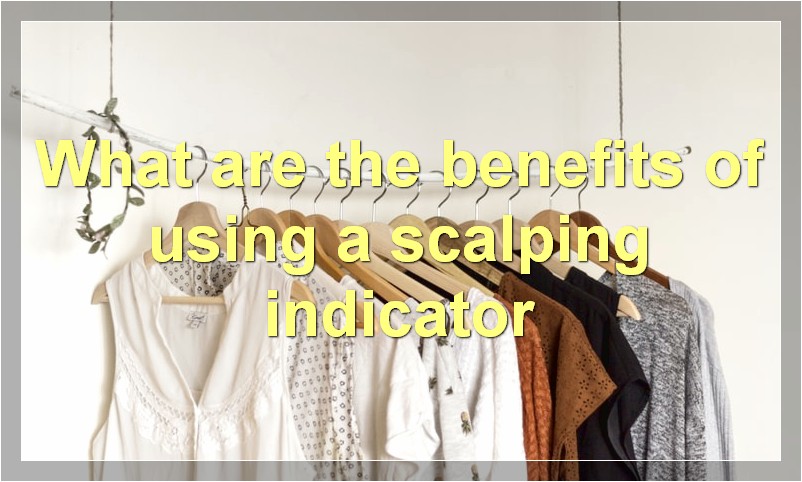If you want to make money through Forex trading, then you need to know how to use a scalping indicator.
What is a scalping indicator
When it comes to trading, there are a lot of different strategies that traders use in order to make money. One popular strategy is scalping. Scalping is a type of trading where traders take advantage of small price changes in the market. In order to do this effectively, they need to use a scalping indicator.
A scalping indicator is a tool that helps traders identify opportunities for scalping. There are a lot of different indicators out there, but some of the most popular ones include the moving average convergence divergence (MACD) and the relative strength index (RSI). These indicators can be used to spot when prices are moving up or down, which can help traders make decisions about when to enter or exit trades.
Indicators are just one tool that traders use to make money from scalping. They also need to have a good understanding of the market and know how to read price charts. If you’re thinking about trying your hand at scalping, make sure you do your research and practice with a demo account first.
How can a scalping indicator be used to trade forex

Scalping is a trading strategy that involves holding a position for a very short period of time and taking advantage of small price movements. A scalping indicator can be used to trade forex by identifying opportunities to buy or sell a currency pair when the price is likely to move in a small but predictable amount.
Scalping can be a profitable trading strategy for forex traders who are able to accurately predict short-term price movements. However, it is important to note that scalping requires a great deal of discipline and patience, as positions are typically only held for a few seconds or minutes.
What are some popular scalping indicators
There are many different scalping indicators that are popular among traders. Some of the most common include moving averages, Bollinger Bands, and RSI. These indicators can help identify when a market is overbought or oversold, and can also give clues as to when a breakout may occur.
How do you choose a scalping indicator
When it comes to choosing a scalping indicator, there are a few things you need to consider. First, what time frame are you looking at? The most popular time frames for scalping are the 1-minute and 5-minute charts. Second, what type of trader are you? Some indicators work better for day traders, while others are better for swing traders. Third, what’s your trading style? Some indicators are better for momentum trading, while others work better for breakout trading. Fourth, what’s your risk tolerance? Some indicators are more accurate than others, but they also tend to generate more false signals. Finally, how much time do you have to trade? Some indicators require more screen time than others.
Once you’ve considered all of these factors, you can start looking at different scalping indicators and see which one fits your needs the best. There are dozens of different indicators out there, so it’s important to do your research and find the one that works best for you.
How do you set up a scalping indicator
There is no one-size-fits-all answer to this question, as the best scalping indicator will vary depending on the trader’s individual preferences. However, some of the most popular scalping indicators include moving averages, Bollinger Bands, and MACD. To set up a scalping indicator, the trader will first need to select the timeframe they wish to trade on (usually 1-5 minutes), and then apply the indicator of their choice. It is also important to remember that scalping is a high-frequency trading strategy, so traders will need to make sure they have a fast and reliable internet connection.
What are the benefits of using a scalping indicator

When it comes to forex trading, there are many different strategies that traders can use to try and make a profit. One popular strategy is scalping, which involves making small but frequent trades in an attempt to take advantage of small price movements.
Some traders prefer to use scalping indicators when carrying out this strategy, as they can help to identify potential entry and exit points as well as providing some useful information about market conditions. In this article, we will take a look at some of the benefits of using a scalping indicator.
One of the main benefits of using a scalping indicator is that it can help you to stay disciplined. It can be easy to get caught up in the excitement of making lots of small trades, but if you don’t stick to your plan then you could end up losing money. A scalping indicator can help you to stick to your strategy by providing clear entry and exit points.
Another benefit of using a scalping indicator is that it can help you to make more informed decisions. By providing information about market conditions, support and resistance levels, and trend direction, you can be better equipped to make decisions about when to enter and exit trades.
Finally, using a scalping indicator can also help you to manage your risk. Because you are looking for small price movements, you can often set tight stop-losses which limits your risk exposure. This can be helpful if you are new to scalping or if you are trying to trade with a small account size.
All in all, there are many benefits of using a scalping indicator when forex trading. If you are thinking of using this strategy, then it may be worth considering using an indicator to help you with your decision making.
What are the risks of using a scalping indicator
When it comes to investing in the stock market, there are a number of different strategies that traders can use to try and make a profit. One popular strategy is known as scalping, which involves trying to make small profits on a large number of trades. While this can be a successful strategy, it also comes with a number of risks that investors should be aware of.
One of the biggest risks of scalping is that it can lead to overtrading. This happens when a trader takes too many trades in a short period of time, which can lead to them making mistakes and losing money. Another risk is that it can be difficult to stick to your trading plan when you’re scalping, as you’re constantly looking for new opportunities. This can lead to you making impulsive decisions and taking unnecessary risks.
Finally, scalping can also be stressful and time-consuming. If you’re not careful, it’s easy to get caught up in the hunt for new trades and end up working all hours of the day. This can lead to burnout and could have an impact on your overall health.
So, while scalping can be a profitable trading strategy, it’s important to be aware of the risks involved before you start using it. By understanding the risks and knowing how to manage them, you’ll be in a better position to succeed in the long run.
What are the pros and cons of using a scalping indicator
There are pros and cons to using a scalping indicator. Some argue that the indicator can help you make quick, profitable trades. Others argue that the indicator can lead to overtrading and cause you to miss out on bigger moves in the market. Ultimately, it is up to the individual trader to decide whether or not using a scalping indicator is right for them.
Is a scalping indicator right for me
As a trader, you’re always looking for an edge. Something that will give you the winning edge in the market. But with so many different trading strategies and indicators out there, it can be tough to know which one is right for you.
One indicator that has gained popularity in recent years is the scalping indicator. Scalping is a short-term trading strategy where traders look to take small profits on each trade. This can be a great strategy if you’re able to find a good scalping indicator.
But before you start using a scalping indicator, there are a few things you need to know. In this article, we’ll go over what scalping is, how to use a scalping indicator, and whether or not it’s right for you.
What is Scalping?
Scalping is a short-term trading strategy that involves taking small profits on each trade. Traders who scalp look for small price movements in the market and try to take advantage of them.
This can be a difficult strategy to master, but if you’re able to do it correctly, it can be very profitable. Scalpers need to have a good understanding of technical analysis and be able to make quick decisions.
How to Use a Scalping Indicator
There are two main ways to use a scalping indicator: as a standalone tool or as part of a larger system.
If you’re using a scalping indicator as part of a system, you’ll need to combine it with other technical indicators or market data. This will help you confirm your trades and make sure you’re getting into and out of them at the right time.
If you’re using a scalping indicator as a standalone tool, you’ll need to be more careful. This is because you won’t have any other confirmation besides the signal from your indicator.
This can be dangerous, so make sure you backtest your indicator before using it live. That way, you’ll know how it works and what kind of signals to expect.
Is Scalping Right for You?
Now that you know what scalping is and how to use a scalping indicator, the next question is: is this strategy right for you?
As with any trading strategy, there are pros and cons to scalping. Let’s go over some of them so you can decide if this is the right approach for your trading style.
Pros:
Can be profitable if done correctly
Allows you to take advantage of small price movements
Cons:
How do I use a scalping indicator
A scalping indicator is a tool that day traders use to make decisions about when to buy and sell securities. This type of indicator typically uses technical analysis to look for patterns in the price data that might indicate a change in direction. Scalpers often use multiple indicators to make their trading decisions, and they may also use other types of information, such as news reports.

